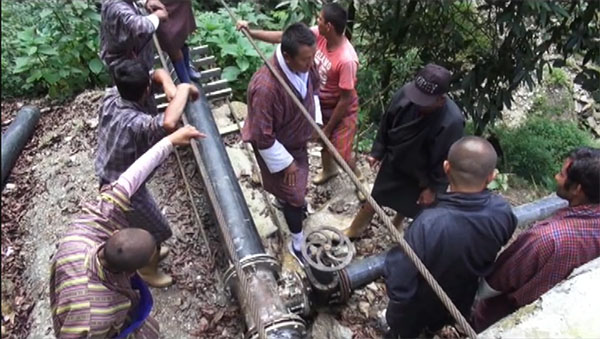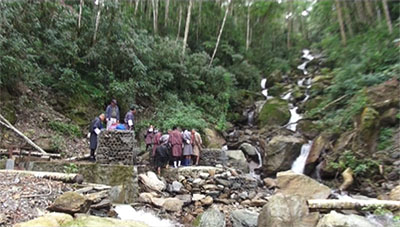 Climate change represents a challenge for rural people; hence adapting irrigation to climate change is a priority for their future. Farmers are vulnerable, as climate change will impact both the demand and the availability of water for agriculture. Villagers at Aringang Midzomsa of Dophuchen Gewog in Samtse are taking a step in the right direction.
Climate change represents a challenge for rural people; hence adapting irrigation to climate change is a priority for their future. Farmers are vulnerable, as climate change will impact both the demand and the availability of water for agriculture. Villagers at Aringang Midzomsa of Dophuchen Gewog in Samtse are taking a step in the right direction.
Lush green paddy plants ripening for harvest in a month’s time. This year, paddy plantation season has been less tiresome for the villagers here in Aringang Midzomsa chiwog formerly known as Somlachen. The new polythene pipe irrigation system has been functioning since July, much to the delight of the farmers.
“It used to be difficult for us in the past. There was no water when we needed it. The government did provide us with pipes but the water was not enough. From this year, our troubles have gone away. We can even stop water whenever we want. I have a lot of hope that things will get even better from here on,” Narath Muni Dahal, a resident, of Aringgang Midzomsa Chiwog, said.
“Before we just had a drain. We used to lose a lot of water due to seepage and it was difficult to channel water through the dense forest. In summer we have to cross the river too. Whenever paddy plantation was going on here in the village, someone had to go to and fro to ensure water connectivity is not disturbed,” Bhim Prasad Chamlagai, the Chiwog Tshogpa, said.
Unlike conventional open irrigation channels, the 2.1-kilometre polythene pipe irrigation system can withstand extreme impact resulting from high water pressure, flood and landslides. The pipes have a life span of at least 50 years.
 “The efficiency in an open channel is just about 50 to 60 per cent. With the pipeline, the efficient is over 90 per cent. With the changing climate, we have to design our system accordingly,” Nedrup Tshewang, the Irrigation Engineer of Department of Agriculture, said.
“The efficiency in an open channel is just about 50 to 60 per cent. With the pipeline, the efficient is over 90 per cent. With the changing climate, we have to design our system accordingly,” Nedrup Tshewang, the Irrigation Engineer of Department of Agriculture, said.
The Food Security and Agriculture Productivity Project of the Department of Agriculture carried out the work worth Nu 17 M with financial assistance from the World Bank.
“No matter how big the water is at the source, a lot of water was lost due to seepage in open channels. Minor landslides and floods also damaged the channels. This leads to water scarcity issues in the villages. That is why we used the polythene pipes from source to the outlet points,” Jigme Dorji, the Project Director of Food Security and Agriculture Productivity Project, said.
With irrigation water aplenty, farmers now want to explore winter crop cultivation which otherwise is non-existent in the chiwog.
“We now do not want to leave agriculture fields fallow even in winter. We have discussed with the agriculture to provide us with seeds of various vegetables. Now we are ready. We will plant potatoes, peas, carrot, spinach, beans, and other vegetables,” Narath Muni Dahal said.
The farmers were also trained on maintaining and cleaning the water source, and operation of drain-out valves by the project officials.
Much of the impact of climate will be felt through the changing patterns of water availability. Ensuring that water for irrigation reaches the fields and in required quantity will go a long way in building climate-resilient agriculture in Bhutan.
Sherub Dorji





